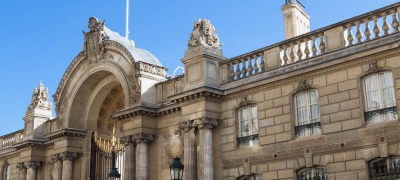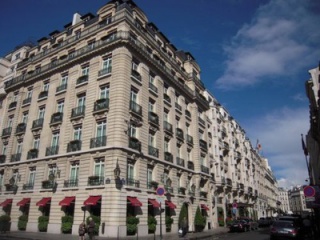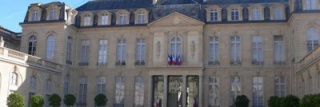Sotheby's International Realty
- 138 Avenue Victor Hugo
- 75116 PARIS, France
- +33 1 40 60 50 00
Sotheby's International Realty
- 50 rue d'Auteuil
- 75016 PARIS, France
- +33 1 56 26 56 55
Sotheby's International Realty
- 82 Avenue de Wagram
- 75017 PARIS, France
- +33 1 46 22 27 27
Sotheby's International Realty
- Place Sainte Foy - 2 Rue de Chézy
- 92200 NEUILLY, France
- +33 1 41 43 06 46
Sotheby's International Realty
- Place Sainte Foy - 2 rue de Chézy
- 92200 NEUILLY, France
- +33 1 41 25 00 00
Sotheby's International Realty
- 37-39 rue de Turenne
- 75003 PARIS, France
- +33 1 48 87 14 41

Paris 8th district - Elysée – Saint-Honoré
The Élysée-Saint Honoré district, located in the prestigious 8th arrondissement of Paris, is one of the most sought-after areas in the capital, known for its rich history, elegant architecture, and economic and cultural dynamism. Bounded by iconic streets such as the rue du Faubourg Saint-Honoré, the Avenue des Champs-Élysées, and the Avenue Montaigne, this district embodies Parisian luxury and is home to some of the city's most famous and influential landmarks.
Historically, the district derives its name from two key elements: the Palais de l’Élysée, the official residence of the President of the French Republic, and the rue Saint-Honoré, an ancient and prestigious thoroughfare known for its haute couture boutiques and grand townhouses. The Palais de l’Élysée, built in the 18th century, is a symbol of power and elegance, attracting visitors from around the world and conferring a unique status on the district. The rue du Faubourg Saint-Honoré, famous for its luxury boutiques and haute couture houses like Chanel, Hermès, and Dior, is a true paradise for fashion enthusiasts and high-end shoppers.
The architecture of the Élysée-Saint Honoré district is a harmonious blend of classical and Haussmannian styles, with majestic stone buildings, sumptuous townhouses, and modern structures housing offices and commercial spaces. The elegant, tree-lined streets create a pleasant and sophisticated atmosphere. Notable buildings include the United States Embassy, one of the largest diplomatic representations in Paris, located on the Place de la Concorde, another iconic site in the district.
The district is also a dynamic business center, hosting the headquarters of numerous large companies, renowned law firms, and financial institutions. Its proximity to the Champs-Élysées, one of the most famous avenues in the world, makes it a convergence point for professionals and tourists alike. Luxury hotels such as the Bristol Paris and the Plaza Athénée add to the prestige and allure of the district, offering refined accommodations to international visitors.
In terms of residential options, the Élysée-Saint Honoré district offers luxury apartments often featuring high-end amenities such as high ceilings, period moldings, and stunning views of iconic monuments like the Eiffel Tower and the Arc de Triomphe. Real estate prices are high, reflecting the exclusivity and constant demand for properties in this coveted area.
The advantages of the Élysée-Saint Honoré district are numerous: a central location, a secure and prestigious environment, a rich cultural offering with museums such as the Grand Palais and the Petit Palais, and green spaces like the gardens of the Champs-Élysées and the Parc Monceau. The district also benefits from excellent transport connections, with several metro stations and bus lines, making it easy to access other parts of Paris.
Free Property Valuation in Élysée / Saint-Honoré – Paris Ouest Sotheby’s International Realty
In the heart of the 8ᵗʰ arrondissement, between the Élysée Palace, Rue du Faubourg Saint-Honoré, and Place Beauvau, this district represents the height of Parisian refinement—where luxury, diplomacy, and history converge. Surrounded by embassies, couture houses, galleries, and exceptional private mansions, the Élysée / Saint-Honoré area attracts a global clientele in search of truly exceptional properties.
Valuing a property in this ultra-prime location requires expert insight and absolute discretion. Key factors include the exact location, floor level, view, quality of finishes, rarity, and long-term potential. The consultants at Paris Ouest Sotheby’s International Realty, specialists in luxury real estate in the 8ᵗʰ arrondissement, provide bespoke valuations perfectly aligned with market expectations.
For a free, personalized, and strictly confidential valuation of your property in Élysée / Saint-Honoré, contact our team at +33 1 46 22 27 27 or fill out our online form.

Rue du Faubourg Saint Honoré
The rue du Faubourg Saint-Honoré, located in the 8th arrondissement of Paris, is an iconic artery embodying luxury, history, and French culture. Among its key landmarks is the Palais de l'Élysée, the official residence of the President of the French Republic, a symbol of political power. The Hôtel Bristol, one of the most luxurious hotels in Paris, is renowned for its exceptional service and Michelin-starred restaurant. Several embassies, notably those of the United States and the United Kingdom, are also located on this prestigious street.
The rue du Faubourg Saint-Honoré is home to some of the best dining establishments in Paris. The restaurant Epicure, located in the Hôtel Bristol and led by chef Eric Frechon, boasts three Michelin stars. Le Gabriel, within the Hôtel La Réserve, offers contemporary French cuisine and holds two Michelin stars. The brasserie Le 114 Faubourg, also at the Hôtel Bristol, offers refined dishes in a relaxed atmosphere and has one Michelin star.
High-end stores and luxury boutiques are numerous on this street. Hermès, with its flagship store, is famous for its handbags, scarves, and other luxury accessories. Chanel offers haute couture, ready-to-wear, and accessories in its iconic store. Lanvin, a historic fashion house, provides elegant and sophisticated collections. The Galerie Perrotin, a renowned contemporary art gallery, showcases internationally acclaimed artists.
Although the street itself does not host prestigious educational institutions, it is close to several notable establishments in the 8th arrondissement. The École Internationale Bilingue (EIB) offers high-quality bilingual education, while the École Saint-Philippe du Roule is renowned for its academic excellence.
The rue du Faubourg Saint-Honoré is characterized by its hôtels particuliers, luxurious residences dating primarily from the 18th and 19th centuries. Its elegant and refined facades are often adorned with wrought iron balconies and French windows. Though mainly urban, the street is near the gardens of the Champs-Élysées and the Parc Monceau, offering nearby green spaces.
Living on the rue du Faubourg Saint-Honoré presents numerous advantages. Residents have direct access to luxury boutiques, Michelin-starred restaurants, and prestigious hotels. The presence of embassies and the Palais de l'Élysée ensures enhanced security in the neighborhood, offering appreciable tranquility. Proximity to renowned art galleries, museums, and performance halls allows easy access to culture and art. Finally, located in the heart of Paris, the street provides easy access to other parts of the city thanks to an excellent public transportation network.
Accurately Value Your Property on Rue du Faubourg Saint-Honoré – Sotheby’s Expertise
An iconic address in Paris’s 8ᵗʰ arrondissement, Rue du Faubourg Saint-Honoré embodies the very essence of Parisian luxury. Renowned for fashion, diplomacy, and fine art, it is home to embassies, historic mansions, haute couture houses, and world-famous galleries. This exceptional street draws a global elite in search of rare and prestigious properties in an unrivalled setting.
Valuing a property on Rue du Faubourg Saint-Honoré requires a highly tailored approach and expert understanding of the ultra-prime market. Exact location, floor level, view, architectural details, interior features, and rarity are all critical factors. The consultants at Paris Ouest Sotheby’s International Realty provide discreet, expert guidance for a valuation that truly reflects the unique nature of your property.
For a free, personalized, and strictly confidential valuation of your property on Rue du Faubourg Saint-Honoré, contact our team at +33 1 46 22 27 27 or fill out our online form.

Avenue de Matignon
L'Avenue de Matignon, located in the prestigious 8th arrondissement of Paris, is an elegant thoroughfare distinguished by its charm, history, and dynamism. This avenue, lined with renowned art galleries, luxury boutiques, and headquarters of major companies, epitomizes Parisian refinement. Culinary options abound, with renowned restaurants such as Le Berkeley, a mythical address just steps from the Champs-Élysées, where you can enjoy carefully curated decor and a menu in a cozy setting designed by architect Jacques Garcia. Restaurant Matignon, a temple of Parisian nightlife whose decor was imagined by Charles Tassin, also comes alive during the day with its restaurant overseen by Jacques Garcia. Refined and modern, the venue is perfect for breakfast on the terrace, lunch under the veranda, or dinner in a golden, softly lit atmosphere. From 11 p.m., Matignon Club and bar open their doors for iconic evenings that keep the capital dancing every night.
The real estate market on Avenue de Matignon is particularly attractive to investors and residents seeking exceptional properties. Properties along this avenue are characterized by great diversity and unparalleled luxury. Magnificent private mansions primarily dating from the 19th century, often meticulously restored to preserve their original splendor while integrating modern amenities, can be found here. These residences boast remarkable architectural features such as ornate facades, wrought-iron balconies, and spacious interiors adorned with elegant moldings and marble fireplaces.
Haussmann-style apartments are also key features of the real estate landscape on Avenue de Matignon. These apartments are distinguished by their high ceilings, large windows allowing abundant natural light, and generous living spaces. Interior finishes are often luxurious, featuring herringbone parquet floors, majestic reception rooms, and kitchens equipped with the latest technologies. Some of these apartments offer breathtaking views of Paris's iconic landmarks, adding additional value to these exceptional properties.
In addition to historic residences, Avenue de Matignon is home to modern buildings designed to meet the needs of contemporary buyers. These buildings offer apartments with high-end amenities such as advanced security systems, private fitness rooms, spas, and concierge services. New real estate developments in this area aim to combine Paris's timeless charm with modern comfort and amenities sought after by an international clientele.
Property prices on Avenue de Matignon are high, reflecting the exclusivity and ongoing demand for properties in this sought-after area. This avenue is seen as a secure investment, offering both prestigious residence and certain heritage value. In summary, Avenue de Matignon offers a sophisticated and exclusive living environment with easy access to high-end services, renowned educational institutions, and a rich cultural life in the heart of Paris. The properties that compose it are among the most luxurious in the capital, ensuring its residents an incomparable lifestyle and one of the most prestigious addresses.
High-End Property Valuation on Avenue de Matignon
A prestigious extension of Rue du Faubourg Saint-Honoré, Avenue de Matignon stands out as one of the most exclusive addresses in Paris’s 8ᵗʰ arrondissement. Home to contemporary art galleries, luxury brand headquarters, renovated private mansions, and exceptional apartments, it attracts a discerning international clientele seeking rare investment opportunities in an ultra-prime environment.
Valuing a property on Avenue de Matignon requires refined expertise and complete discretion. Every detail matters: precise location, floor level, light, surface area, amenities, architectural style, building prestige, and heritage value. The consultants at Paris Ouest Sotheby’s International Realty offer rigorous, bespoke support for valuations that reflect the true standing of your property.
For a free, personalized, and strictly confidential valuation of your property on Avenue de Matignon, contact our team at +33 1 46 22 27 27 or fill out our online form.




